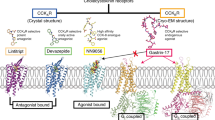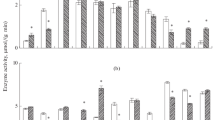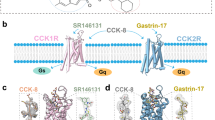Abstract
Prior calculations based on ECEPP (Empirical Conformational Energies for Peptides Program) of the low energy minima for cholecystokinin (CCK) and Met-enkephalin have demonstrated that significant structural features of these two peptides are identical. This result suggested the possibility that Met-enkephalin, as well as other enkephalin analogues of similar structure, could associate with receptors for CCK. To test this theoretical result, we examined the ability of Met-enkephalin and its analogues to bind to peripheral CCK receptors in the rat gastrointestinal tract; in particular, we measured the ability of the opiate peptide to inhibit the effects of CCK in a physiological assay system which we have previously characterized: CCK-induced contraction of the isolated rat pyloric sphincter. We find that Met-enkephalin is an antagonist of the CCK-8-induced contraction, with a IC50 of 110 nM. Furthermore, antibodies against CCK were found to cross-react with Met-enkephalin and its analogues in a manner which suggests a distinct structure-activity relationship. These experimental results strongly support the theoretical results of conformational analysis showing structural similarity between enkephalin and CCK. They further suggest that enkephalins could modulate the response of CCK systems under physiological conditions.
Similar content being viewed by others
References
Allescher, H.-D., Daniel, E. E., Dent, J., Fox, J. E. T., and Kostolaska, F. (1988).J. Physiol. (London)401, 17–38.
Antin, J., Gibbs, J., Holt, J., Young, R. C., and Smith, G. P. (1975).J. Comp. Physiol. Psych. 89, 784–790.
Beinfeld, M. C., Meyer, D. R., Eskay, D. L., Jensen, R. T., and Brownstein, M. J. (1979).Brain Res. 212, 51–57.
Chang, R. S. L., Lotti, V. J., Chen, T. B., and Kunkel, K. A. (1986).Mol. Pharm. 30, 212–217.
Chang, R. S. L., and Lotti, V. J. (1986).Proc. Natl. Acad. Sci. USA 83, 4923–4926.
Cox, K. L., Schrenck, T. M., Moran, T. H., Gardner, J. D., and Jensen, R. T. (1990).Am. J. Physiol. 259, G873-G881.
Evans, B. E., Bock, M. G., Rittle, K. E., DiPardo, R. M., Whitter, W. L., Veber, D. F., Anderson, P. S., and Friedinger, R. M. (1986).Proc. Natl. Acad. Sci. USA 83, 4918–4922.
Gintzler, A. R., and Hyde, D. (1984).Proc. Natl. Acad. Sci. USA 81, 2252–2254.
Grider, J. R., and Makhlouf, G. M. (1990).Am. J. Physiol. 259, G184-G190.
Isogai, Y., Nemethy, G., and Scheraga, H. A. (1977).Proc. Natl. Acad. Sci. USA 74, 414–418.
Katsushima, S., Adachi, H., Honda, T., Sato, S., Kusui, T., Onishi, S., Aoki, E., Noguchi, M., and Konishi, J. (1990).Am. J. Physiol. 258, G395-G403.
Lotti, V. J., Pendelton, R. G., Gould, R. J., Hanson, H. M., Chang, R. S. L., and Clineschmidt, B. V. (1987).J. Pharmacol. Exptl. Therap. 241, 103–109.
Moran, T. H., Robinson, P. H., Goldrich, M. S., and McHugh, P. R. (1986).Brain Res. 362, 175–179.
Murphy, R. B., Smith, G. P., and Gibbs, J. (1987).Peptides 8, 127–134.
Nemethy, G., Pottle, M., and Scheraga, H. A. (1983).J. Phys. Chem. 87, 1883–1887.
Paine, G. H., and Scheraga, H. A. (1985).Biopolymers 24, 1391–1436.
Purisima, E., and Scheraga, H. A. (1987).J. Mol. Biol. 196, 697–709.
Pincus, M. R., Gerewitz, F., Wako, H., and Scheraga, H. A. (1983).J. Protein Chem. 2, 131–139.
Pincus, M. R., Carty, R. P., Chen, J. M., Lubowsky, J., Avitable, M., Shah, D., Scheraga, H. A., and Murphy, R. B. (1987).Proc. Natl. Acad. Sci. USA 84, 4821–4825.
Pincus, M. R., Murphy, R. B., Carty, R. P., Chen, J. M., Shah, D., and Scheraga, H. A. (1988).Peptides 9 (Suppl. 1), 145–152.
Pincus, M. R. (1988).Int. J. Quantum Chemistry: Quantum Biology Symposium 15, 209–220.
Reynolds, J. C., Ouyang, A., and Cohen, S. (1984).Am. J. Physiol. 246, G130-G136.
Schneider, L. H., Murphy, R. B., Gibbs, J., and Smith, G. P. (1988). InCholecystokinin Antagonists (Wang, R. Y., and Schonfeld, R., eds.) A. Linn, New York, pp. 263–284.
Shah, D., Chen, J. M., Carty, R. P., Pincus, M. R., and Scheraga, H. A. (1989).Int. J. Peptide Protein Res. 34, 325–332.
Von Schrenck, R., Moran, T. H., Heinz-Erian, P., Gardner, J. D., and Jensen, R. T. (1988).Am. J. Physiol. 255, G512-G521.
Vinayek, R., Jensen, R. Y., and Gardner, J. D. (1986).Gastroenterology 90, 1681.
Author information
Authors and Affiliations
Rights and permissions
About this article
Cite this article
Murphy, R.B., Pincus, M.R., Beinfeld, M. et al. Enkephalin is a competitive antagonist of cholecystokinin in the gastrointestinal tract, as predicted from prior conformational analysis. J Protein Chem 11, 723–729 (1992). https://doi.org/10.1007/BF01024973
Received:
Published:
Issue Date:
DOI: https://doi.org/10.1007/BF01024973




